Twisted Stitch Argyle, a free knitting pattern from Knitty.com. Free knitting pattern for toe-up heel-flap sock with a twisted stitch argyle pattern
INTRODUCTION
Twisted Stitch Argyle
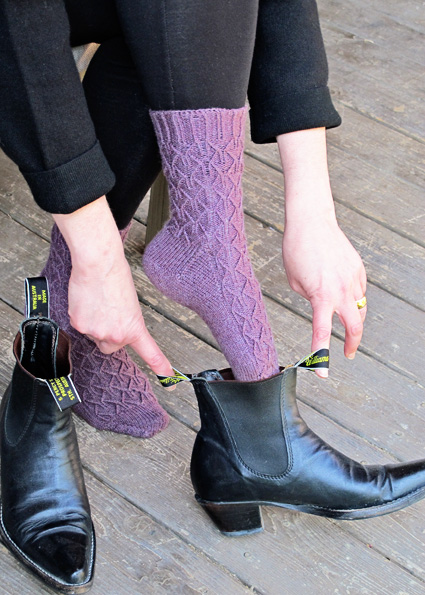 by Kate Atherley
by Kate Atherley
![]()
The last in a series of four sock patterns, each worked in Regia's new Premium line of sock yarns. Each of the four has a stitch pattern inspired by argyle, and this one uses one of my most favorite techniques: twisted stitches. This makes a handsome sock, suitable for all styles and tastes.
This one is worked toe-up because I prefer the pattern alignment, but as always the sock has a gusset-and-flap heel, for better fit.
The heel turn and flap aren't reinforced, but the fiber blend for this one is already very strong: wool, and nylon with added silk. Silk adds a bit of shine, a bit of extra warmth, and some strength.
If you do wish to reinforce, I'd suggest you consider using a purpose-made carry-along thread, of a similar fiber blend. Regia sells cards of it. Use that along with the main yarn when you work the heel turn and flap. If you wish, you can also double-strand the main yarn for those portions; note that in that case, you'll want to use a needle a size or two larger (not that much larger) and work slowly, since the much-denser fabric can be hard on your hands and needles.
 model: Kate Atherley
model: Kate Atherley
 photos: Norman Wilner
photos: Norman Wilner
SIZE
Adult XXS[XS, S, M, L, XL, XXL, XXXL]
FINISHED MEASUREMENTS
Foot circumference: 6[6.5, 7, 7.5, 8, 8.5, 9, 9.5] inches/ 15[16.5, 18, 19, 20.5, 21.5, 23, 24] cm
Leg length: 6.5 inches/16.5 cm as shown, adjustable to preference
Foot length: adjustable to preference
Note: Choose a size with approximately 0.5-1 inch/1.5-2.5 cm negative ease in the foot circumference.
MATERIALS
Yarn
![]() Regia Premium Silk 4-ply [55% wool, 25% nylon, 20% silk; 437 yd/400m per 100 g ball]; color: 00045, 1 ball
Regia Premium Silk 4-ply [55% wool, 25% nylon, 20% silk; 437 yd/400m per 100 g ball]; color: 00045, 1 ball
Recommended needle size
[always use a needle size that gives you the gauge listed below - every knitter's gauge is unique]
![]() US #1/2.25mm needles for small circumference in the round: traditional or flexible DPNs, 1 long circular for magic loop, or 2 short circulars, as you prefer
US #1/2.25mm needles for small circumference in the round: traditional or flexible DPNs, 1 long circular for magic loop, or 2 short circulars, as you prefer
![]() US #1.5/2.5mm needles for small circumference in the round: traditional or flexible DPNs, 1 long circular for magic loop, or 2 short circulars, as you prefer
US #1.5/2.5mm needles for small circumference in the round: traditional or flexible DPNs, 1 long circular for magic loop, or 2 short circulars, as you prefer
Notions
![]() stitch markers
stitch markers
![]() cable needle
cable needle
![]() yarn needle
yarn needle
GAUGE
32 sts/48 rounds = 4 inches/10 cm in stockinette stitch on larger needles
36 sts/52 rounds = 4 inches/10 cm in stockinette stitch on smaller needles
PATTERN NOTES
[Knitty's list of standard abbreviations and techniques can be found here.]
Judy's Magic CO
Instructions for Judy's Magic Cast On can be found here.
1/1 LPT: Slip the next st to a cable needle and hold in front of work; p1, then k1 from cable needle.
1/1 RPT: Slip the next st to a cable needle and hold in back of work; k1, then p1 from cable needle.
You can choose to work the cables without a cable needle, but because of the size of the stitches, you'll need very pointy needles and a careful hand.
DS – Make a double stitch, for a short-row turn as follows: With yarn in front, slip next stitch purlwise; tug on working yarn and take it over top of the right-hand needle, pulling the stitch it's attached to up onto the needle, so that both legs are up, as if it's a double stitch. When working these double stitches on following rows, working through both legs as if they are one.
CHARTS
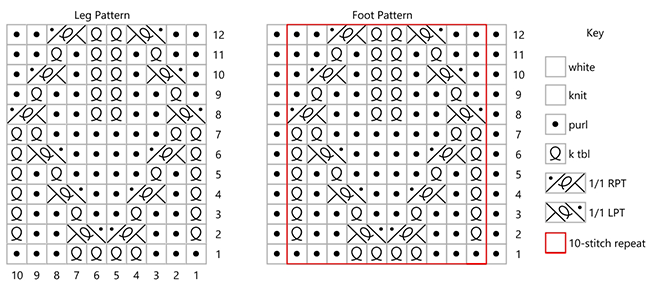
DIRECTIONS
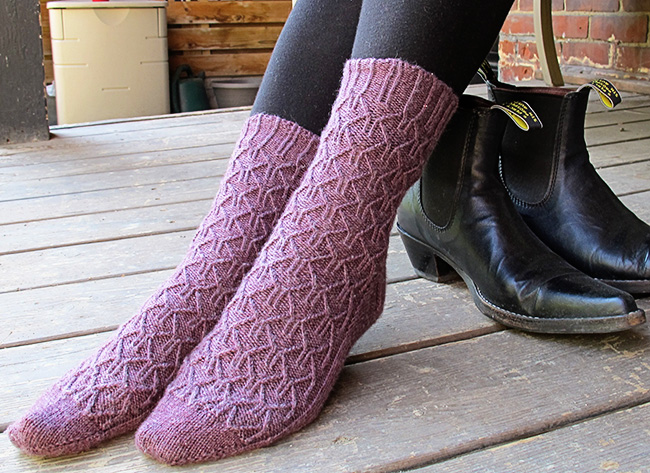
Toe
Using larger needles, and Judy's Magic Cast On method, CO 18[18, 18, 20, 24, 24, 24, 28] sts, 9[9, 9, 10, 12, 12, 12, 14] on each side.
Knit 1 round, working any twisted stitches through the back loop. Distribute the sts across your needles and place markers as required so that you can identify the start and the mid-point of the round. This mid-point will mark the end of the instep and the start of the sole.
Round 1, increase: K1, m1R, knit to 1 st before end of instep, m1L, k1; k1, m1R, knit to 1 st before end of round, M1L, k1. 4 sts increased.
Round 2: Knit.
Repeat Rounds 1-2 7[8, 9, 10, 10, 11, 12, 12] more times. 50[54, 58, 64, 68, 72, 76, 80] sts total, 25[27, 29, 32, 34, 36, 38, 40] each on instep and sole.
Next round, increase for pattern: Knit around, increasing 3[3, 3, 4, 4, 4, 4, 6] sts evenly distributed across instep sts, as outlined below:
Sizes XXS, XS, S only:
(K6[7, 7, -, -, -, -, -], m1) 3 times, knit to end of round. 28[30, 32, -, -, -, -, -] sts on instep.
Size M and XXL only:
(K-[-, -, 6, -, -, 8, -], m1) 3 times, k7, m1, knit to end of round. -[-, -, 36, -, -, 42, -] sts on instep.
Size L and XL only:
(K7, m1) 4 times, knit to end of round. -[-, -, -, 38, 40, -, -] sts on instep
Size XXXL only:
K5, m1, (k6, m1) 5 times, knit to end of round. 46 sts on instep.
53[57, 61, 68, 72, 76, 80, 86] sts total.
Next round, sizes S and XXL only: Knit. The first -[-, 32, -, -, -, 42, -] sts form the instep. Rearrange sts as you prefer.
Next round, all other sizes - adjust start of round and setup for pattern: Knit to 2[1, -, 3, 2, 1, -, 3] sts before end of round. This is the new start of round position, and the first 32[32, -, 42, 42, 42, -, 52] sts form the instep. Rearrange sts as you prefer.
21[25, 29, 26, 30, 34, 38, 34] sts for the sole.
Foot round: Work Foot Pattern across instep, working 10-st repeat 3[3, 3, 4, 4, 4, 4, 5] times; knit to end of round.
Work even in pattern as set until sock foot measures 2.5[3, 3.25, 3.5, 3.75, 4, 4.25, 4.5] inches/ 6.5[7.5, 8.5, 9, 9.5, 10, 11, 11.5] cm short of desired finished foot length, ending with an odd-numbered pattern round. Make note of which round you ended on, so you can make the second sock match the first.
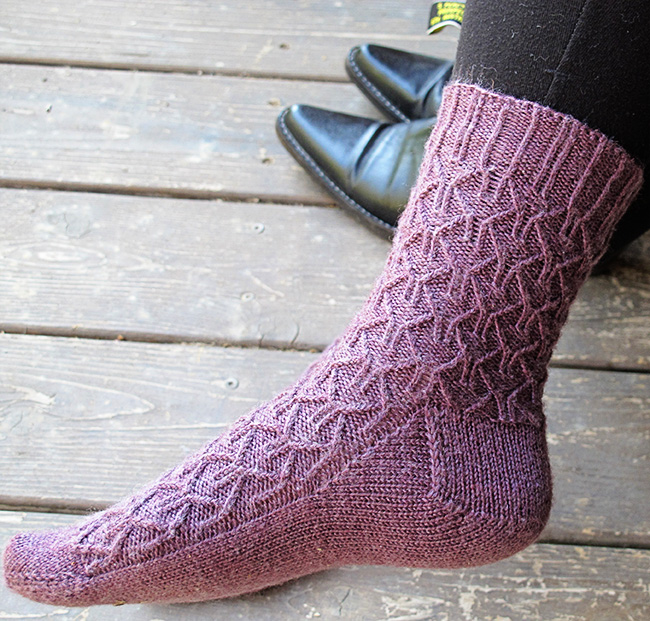
Gusset
Round 1, setup for gusset: Work across instep in pattern as set, m1R, pm, knit to end of round, pm, M1L. 2 sts increased on sole, for gusset.
Round 2: Work across instep in pattern as set, knit to end of round.
Round 3, increase: Work across instep in pattern as set, m1R, knit to end of round, M1L. 2 sts increased on sole, for gusset.
Round 4: Work across instep in pattern as set, knit to end of round.
Repeat Rounds 3-4 7[8, 9, 10, 11, 12, 13, 14] more times. 39[45, 51, 50, 56, 62, 68, 66] sts on sole, 9[10, 11, 12, 13, 14, 15, 16] sts for gusset each side.
Make a note of the last Foot Pattern Round worked – you'll need this when you start the leg.
Heel Turn
Change to smaller needles. Depending on your set-up you can just introduce a pair of smaller needles for the sole stitches and leave the instep sts on the larger size needle.
Row 1 [RS]: Work across instep in pattern as set, knit to second marker, remove marker and turn.
The heel turn will be worked on the 21[25, 29, 26, 30, 34, 38, 34] sts in the center of the sole (those between the markers); for ease of working leave all the gusset and sole sts grouped together.
Row 2 [WS]: DS, purl to first marker, remove marker and turn.
Row 3: DS, knit to DS, turn.
Row 4: DS, purl to DS, turn.
Repeat Rows 3-4 until there are 7[8, 10, 9, 10, 11, 13, 11] DS at the left-hand side of the heel sts and 6[7, 9, 8, 9, 10, 12, 10] at the right-hand size of the heel sts, when counted with RS facing.
Heel Flap
Row 1 [RS]: DS, k 7[9, 9, 8, 10, 12, 12, 12] , k 7[8, 10, 9, 10, 11, 13, 11] DS, working into both legs of the double st, work ssk on the next (last) DS, and the first gusset st. 1 gusset st decreased.
Row 2 [WS]: Sl1 pwise wyif, p 13[16, 18, 16, 19, 22, 24, 22] , p 7[8, 9, 9, 10, 11, 12, 12] DS, working into both legs of the double st, work p2tog on the next (last) DS, and the first gusset st. 1 gusset st decreased.
Row 3: Sl1 pwise wyib, k 19[23, 27, 24, 28, 32, 36, 32] , ssk, turn. 1 gusset st decreased.
Row 4: Sl1 pwise wyif, p 19[23, 27, 24, 28, 32, 36, 32] , p2tog, turn. 1 gusset st decreased.
Repeat Heel Flap Rows 3-4 until 1 gusset st rems on each side. 55[59, 63, 70, 74, 78, 82, 88] sts total.
Return to working only with the larger needles.
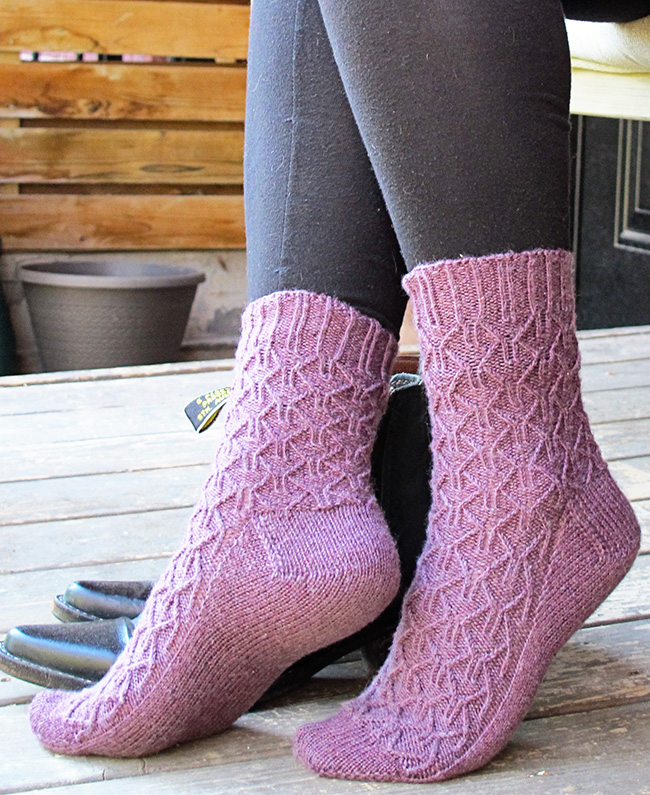
Leg
Leg round 1, final gusset decreases: Sl1 pwise wyib, k 19[23, 27, 24, 28, 32, 36, 32] , ssk, work across instep in pattern as set, k2tog, knit to end of round. 53[57, 61, 68, 72, 76, 80, 86] sts.
Note: For all sizes but XXL, you need to adjust the stitch count on the heel/back of leg stitches to accommodate the pattern. For size XXL, just proceed to the following instruction for All sizes.
Size XXS only: Sl1 pwise wyib, k2, [k2tog, k5] twice, k2tog, knit to instep; work across instep in pattern as set. 18 sts on back of leg, 50 sts total.
Size XS only: Sl1 pwise wyib, [k6, m1] 3 times, knit to instep; work across instep in pattern as set. 28 sts on back of leg, 60 sts total.
Size S only: Sl1 pwise wyib, k13, k2tog, knit to instep; work across instep in pattern as set. 28 sts on back of leg, 60 sts total.
Size M only: Sl1 pwise wyib, [k8, m1] twice, knit to instep; work across instep in pattern as set. 28 sts on back of leg, 70 sts total.
Size L only: Sl1 pwise wyib, [k8, k2tog] 2 times, k9, work across instep in pattern as set. 28 sts on back of leg, 70 sts total.
Size XL only: Sl1 pwise wyib, [k7, m1] 4 times, knit to instep; work across instep in pattern as set. 38 sts on back of leg, 80 sts total.
Size XXXL only: Sl1 pwise wyib, [k7, m1] 4 times, knit to instep; work across instep in pattern as set. 38 sts on back of leg, 90 sts total.
All sizes continue here
Leg stitch count is set. Read ahead before you proceed. From here, you will continue to knit the back of leg stitches and work the instep sts in pattern as set until you hit Round 12 of the Foot pattern. If you're already at Round 12, skip the Transition rounds.
Transition rounds: Knit to instep, work across instep in pattern as set.
Work as set until you have completed Round 12 of the Foot pattern.
Next step, adjust start of round: P1. This is the new start of round. Rearrange sts as you prefer.
Leg round: Work Leg pattern around, working 10-st repeat 5[6, 6, 7, 7, 8, 8, 9] times around.
Work even in pattern as set until leg is approximately 1.75 inches/4 cm short of desired length, ending with Round 3 or 9. This round sets the ribbing.
Change to smaller needles.
Work in ribbing pattern as set for 1.75 inches/4 cm.
Bind off as follows: K1, *k1, return the 2 sts back to left needle without twisting and k2tog-tbl; repeat from * until all sts have been worked. Cut yarn and pull through final st to secure.

FINISHING
Wash to block and weave in ends. Sock blockers aren't necessary, the socks will stretch out nicely on your feet.
ABOUT THE DESIGNER
 Kate is rather a fan of interesting socks that fit well. Did you know she wrote a whole book about it?
Kate is rather a fan of interesting socks that fit well. Did you know she wrote a whole book about it?
You can see more of her work at kateatherley.com, and on Ravelry.
Pattern & images © 2020 Kate Atherley